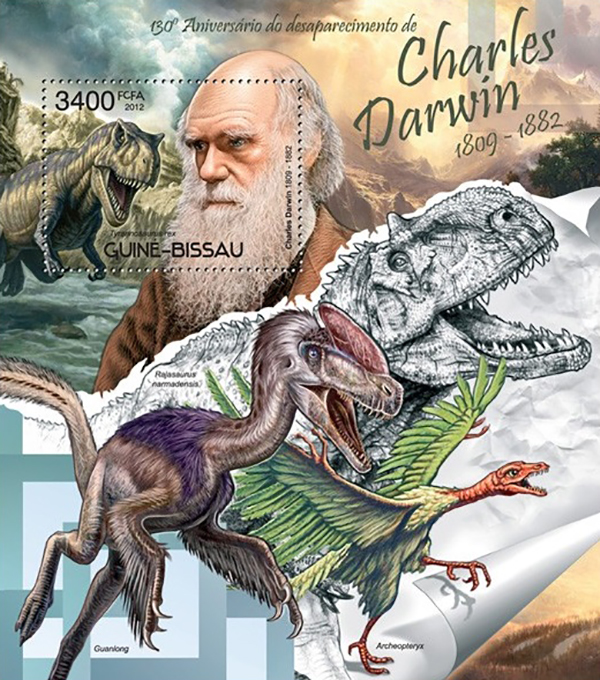Rajasaurus narmadensis Wilson et al., 2003

(Da: en.wikipedia.org)
Phylum: Chordata Haeckel, 1874
Subphylum: Vertebrata Cuvier, 1812
Classe: Dinosauria Owen, 1841
Ordine: Saurischia Seeley, 1887
Famiglia: Abelisauridae Bonaparte & Novas, 1985
Genere: Rajasaurus Wilson et al., 2003
Descrizione
L'aspetto di questo animale era impressionante: il rajasauro è uno dei dinosauri carnivori più robusti mai rinvenuti. La testa era corta e profonda, fornita di una strana "cresta - corno" divisa in due, caratteristica simile ad altri animali affini, gli abelisauridi. Il rajasauro era lungo circa nove metri e alto tre, e doveva essere il massimo predatore del suo habitat. Le ossa dello scheletro indicano che la corporatura di questo dinosauro doveva essere davvero massiccia, e probabilmente non era un veloce corridore ma attaccava le sue prede con agguati rapidi e precisi, utilizzando la sua enorme mole per abbatterle. Descritto nel 2003 sulla base di resti piuttosto completi rinvenuti in India (Gujarat e Madhya Pradesh) negli anni '80, il rajasauro è stato subito riconosciuto come un appartenente agli abelisauridi, un gruppo di dinosauri carnivori primitivi caratteristici dei continenti meridionali. In particolare, la forma del cranio sembrerebbe suggerire strette parentele con il Majungatholus del Madagascar e con il Carnotaurus dell'Argentina. Questi dinosauri, così simili tra loro eppure rinvenuti in posti così distanti, si evolsero quando ancora l'India, il Madagascar e il Sudamerica erano uniti, insieme all'Antartide, in ciò che rimaneva dell'antico supercontinente Gondwana. Prima della scoperta di Rajasaurus erano stati rinvenuti in India altri resti frammentari attribuiti ad abelisauridi (ad esempio Indosaurus e Indosuchus); lo studio dei nuovi resti più completi potrebbe far luce sulla tassonomia degli abelisauri del subcontinente indiano. Un altro abelisauro indiano di grandi dimensioni, rinvenuto negli stessi luoghi, è lo snello Rahiolisaurus.
Diffusione
Dinosauro carnivoro di grosse dimensioni vissuto nel Cretacico superiore (Maastrichtiano, circa 70 milioni di anni fa) in India.
Bibliografia
–Rajasaurus narmadensis – India's own dinosaur emerges from oblivion" (PDF). Geological Survey of India.
–Wilson, J. A.; Sereno, P. C.; Srivastava, S.; Bhatt, D. K.; Khosla, A.; Sahni, A. (2003). "A new abelisaurid (Dinosauria, Theropoda) from the Lameta Formation (Cretaceous, Maastrichtian) of India" (PDF). Contributions from the Museum of Paleontology University of Michigan. 31 (1): 1-42.
–Carrano, M. T.; Sampson, S. D. (2008). "The phylogeny of Ceratosauria" (PDF). Journal of Systematic Palaeontology. 6 (2): 183-236.
–Paul, G. S. (2010). The Princeton Field Guide to Dinosaurs. Princeton University Press. pp. 84-86.
–Grillo, O. N.; Delcourt, R. (2016). "Allometry and body length of abelisauroid theropods: Pycnonemosaurus nevesi is the new king". Cretaceous Research. 69: 71-89.
–Rogers, Raymond R.; Krause, David W.; Curry Rogers, Kristina; Rasoamiaramanana, Armand H.; Rahantarisoa, Lydia. (2007). Sampson, S. D.; Krause, D. W. (eds.). "Majungasaurus crenatissimus (Theropoda: Abelisauridae) from the Late Cretaceous of Madagascar". Paleoenvironment and Paleoecology of Majungasaurus crenatissimus (Theropoda: Abelisauridae) from the Late Cretaceous of Madagascar. Journal of Vertebrate Paleontology. Society of Vertebrate Paleontology Memoir 8. 27: 21-31.
–Delcourt, R. (2018). "Ceratosaur Palaeobiology: New Insights on Evolution and Ecology of the Southern Rulers". Scientific Reports. 8 (9730): 9730.
–J.A. Wilson, P.C. Sereno, S. Srivastava, D.K. Bhatt, A. Khosla and A. Sahni, 2003, "A new abelisaurid (Dinosauria, Theropoda) from the Lameta Formation (Cretaceous, Maastrichtian) of India", Contributions from the Museum of Paleontology, University of Michigan 31(1): 1-42.
–Molina-Pérez, Rubén; Larramendi, Asier; Atuchin, Andrey; Mazzei, Sante; Connolly, David; Cruz, Gonzalo Ángel Ramírez (2019). Dinosaur Facts and Figures: The Theropods and Other Dinosauriformes. Princeton University Press.
–Sampson, Scott D.; Witmer, L. M. (2007). Sampson, S. D.; Krause, D. W. (eds.). "Majungasaurus crenatissimus (Theropoda: Abelisauridae) from the Late Cretaceous of Madagascar" (PDF). Craniofacial anatomy of Majungasaurus crenatissimus (Theropoda: Abelisauridae) from the Late Cretaceous of Madagascar. Journal of Vertebrate Paleontology. Society of Vertebrate Paleontology Memoir 8. 27: 32-102.
–Mathur, U. B. ubmathur (2004). "Rajasaurus narmadaensis" (PDF). Current Science. 86 (6).
–Sereno, P. C.; Brusatt, S. L. (2008). "Basal abelisaurid and carcharodontosaurid theropods from the Lower Cretaceous Elrhaz Formation of Niger" (PDF). Acta Palaeontologica Polonica. 53 (1): 15-46.
–Sereno, P. C.; Wilson, J. A.; Conrad, J. L. (2004). "New dinosaurs link southern landmasses in the Mid–Cretaceous". Proceedings of the Royal Society B. 271 (1546): 1325-1330.
–Tortosa, T.; Buffetaut, E.; Vialle, N.; Dutour, Y.; Turini, E.; Cheylan, G. (2014). "A new abelisaurid dinosaur from the Late Cretaceous of southern France: Palaeobiogeographical implications". Annales de Paléontologie. 100 (1): 63-86.
–Kapur, V. V.; Khosla, A. (2016). "Late Cretaceous terrestrial biota from India with special reference to vertebrates and their implications for biogeographic connections". Cretaceous Period: Biotic Diversity and Biogeography. 71: 161-172.
–Persons IV, W. S.; Currie, P. J. (2011). "Dinosaur speed demon: the caudal musculature of Carnotaurus sastrei and implications for the evolution of South American abelisaurids".
–Brookfield, M. E.; Sanhi, A. (1987). "Palaeoenvironments of the Lameta beds (late Cretaceous) at Jabalpur, Madhya Pradesh, India: Soils and biotas of a semi-arid alluvial plain". Cretaceous Research. 8 (1): 1-14.
–Mohabey, D. M. (1996). "Depositional environment of Lameta Formation (late Cretaceous) of Nand-Dongargaon inland basin, Maharashtra: the fossil and lithological evidences". Memoirs of the Geological Survey of India. 37: 1-36.
–Tandon, S. K.; Sood, A.; Andrews, J. E.; Dennis, P. F. (1995). "Palaeoenvironments of the dinosaur-bearing Lameta Beds (Maastrichtian), Narmada Valley, Central India" (PDF). Palaeogeography, Palaeoclimatology, Palaeoecology. 117 (3–4): 153-184.
–Lovgren, S. (13 August 2003). "New Dinosaur Species Found in India". National Geographic News.
–Sonkusare, H.; Samant, B.; Mohabey, D. M. (2017). "Microflora from Sauropod Coprolites and Associated Sedimentsof Late Cretaceous (Maastrichtian) Lameta Formation of Nand-Dongargaon Basin, Maharashtra". Geological Society of India. 89 (4): 391-397.

|
Data: 25/05/2012
Emissione: Charles Darwin (1809-1882) Stato: Guinea-Bissau Nota: Presente nel foglietto |
|---|